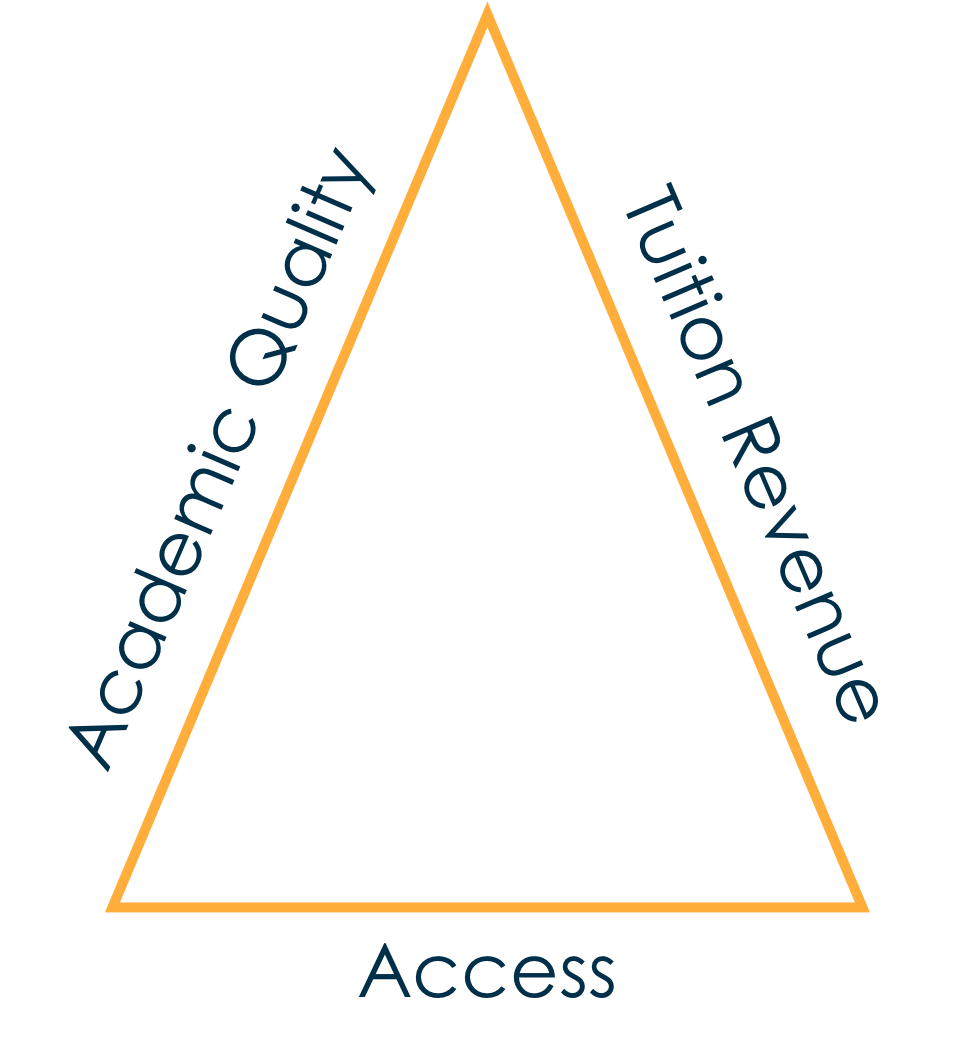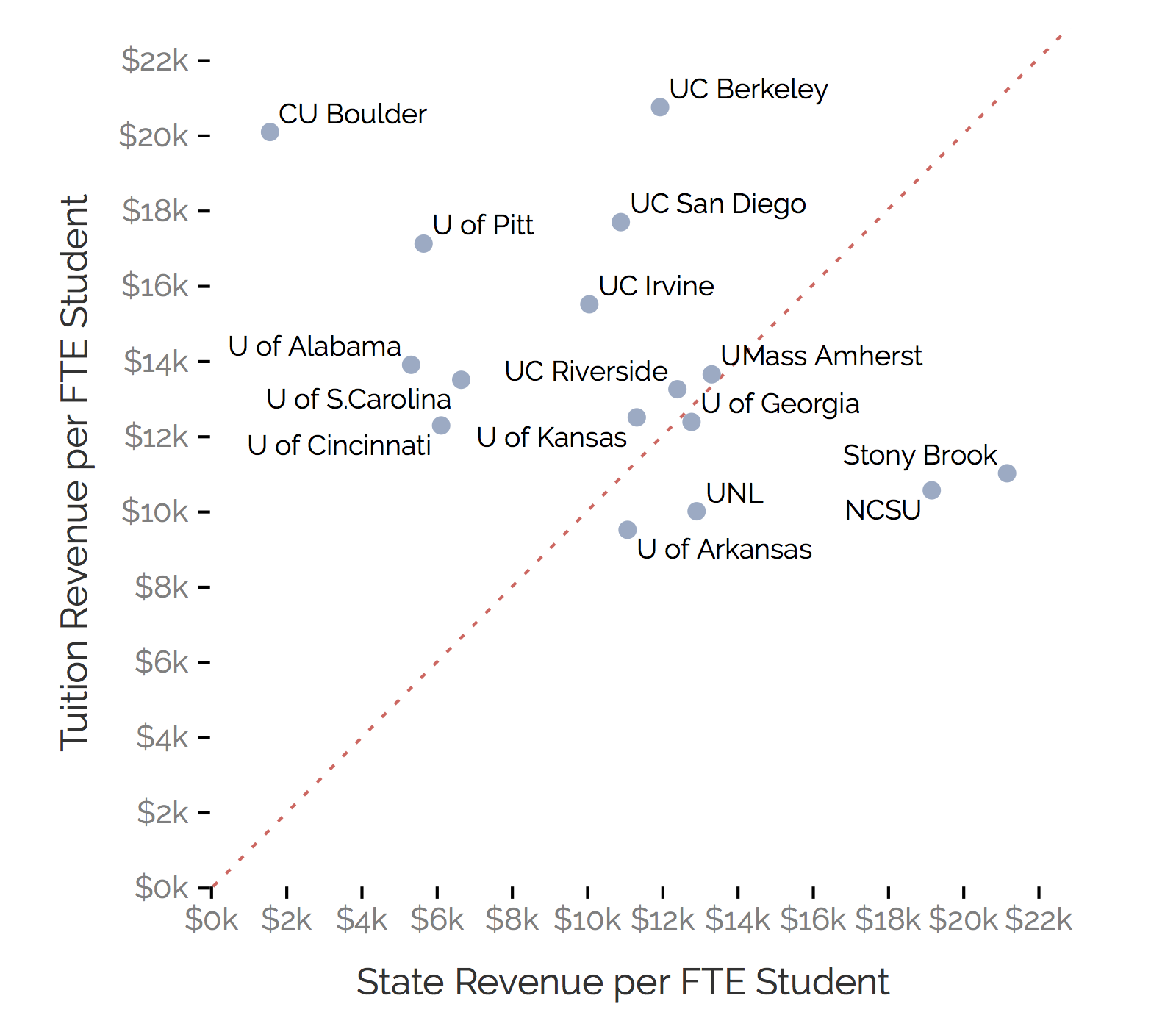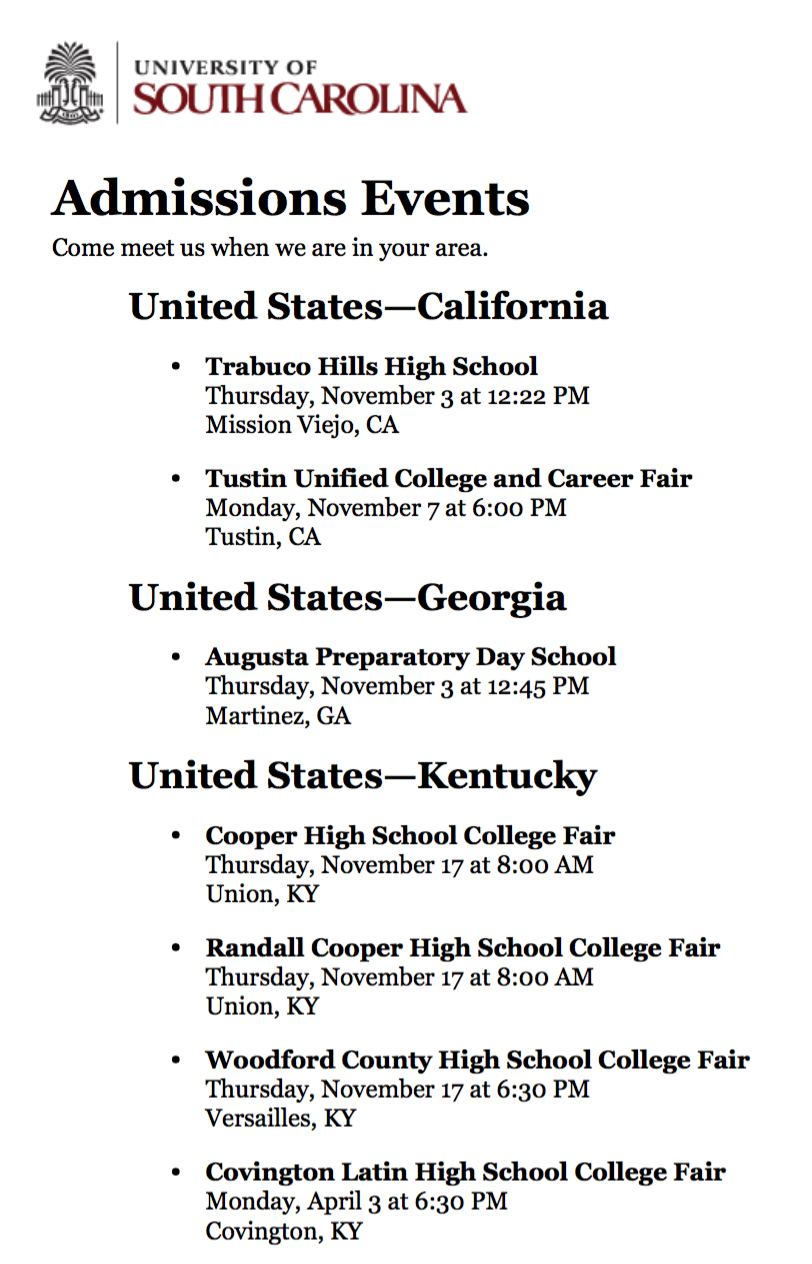Follow the Money
Recruiting and the Enrollment Priorities of Public Research Universities
Ozan Jaquette
University of California, Los Angeles
Crystal Han
University of California, Los Angeles
Karina Salazar
University of Arizona


Acknowledgments
This research was made possible by funding from the following sources:
- Joyce Foundation (Research Grant)
- National Academy of Education/Spencer Foundation (Postdoctoral Fellowship)
- American Educational Research Association (Dissertation Grant)
- UCLA Office of Equity, Diversity, and Inclusion (Faculty Career Development Award)
Motivation
Policy discourse on college access inequality
The 2014 White House "Access Summit"
- The White House (2014) reviews causes of access inequality
- Demand-side explanations; e.g., "achievement gap", "under-matching"
- Place responsibility on students, K-12 schools
- The White House (2014) asks universities for Commitments to Action on College Opportunity
- Universities pledge "action plans" (e.g., need-based financial aid, "outreach", holistic admission)
Why study marketing, recruiting
- Enrollment management is an opaque industry
- Rhetoric: "despite state disinvestment (and student deficiencies), we care about access"
- Internal resource allocation is better indicator of organizational priorities than rhetoric, policies
- Knowing which student populations are targeted by recruiting efforts indicates enrollment priorities
Research goal:
- Document enrollment management behaviors, push policy discourse to consider supply-side
Background
The "enrollment funnel"

Interventions along the funnel
- Identify prospects
- e.g., buy "student lists"
- Recruit prospects remotely
- Email, mail, text, etc.
- Recruit prospects in-person
- Off-campus visits (e.g., schools, fairs)
- On-campus visits
- Other "outreach"
- Marketing/ads (inquiries, stealth applicants)
- Search engine marketing
- Social media marketing
- Traditional advertising
- Convert admits to enrollees
- e.g., financial aid leveraging
Conceptual Framing
The behavior of US universities, according to Mitchell Stevens
The "sieve" function of higher education (Stevens, Armstrong, and Arum, 2008)
- Higher education allocates people to different occupational/social positions
- Dual character of education (Weber, 1948), simultaneously serves
- Social mobility: redistributing access to privileged positions
- Social reproduction: privileged families get access to universities that confer the best positions
Political economy of US higher education (Stevens and Gebre-Medhin, 2016):
- "National service" orientation
- Expansion of federal and state investment in higher ed
- Creation of state higher education systems
- "Market" orientation
- Demographic contraction; state disinvestment
- Transportation, technology advances, national guidebooks and rankings create national market
Conceptual Framing
The political economy of enrollment management
Iron triangle of enrollment management

"National service" political economy
- Universities as civil service orgs
- State demands human capital development, equality of opportunity
- University enrollment goals
- Access; academic quality
- The "sieve" serves
- Mobility and reproduction
"Market" political economy
- Universities as self-interested corporations
- University enrollment goals
- Revenue; academic quality (rankings)
- The "sieve" serves
- Social reproduction (paying customers)
Empirical context
State funding and tuition revenue, sample institutions in 2016-17

Empirical context
Nonresident enrollment growth at public research universities
Effect of state appropriations on nonresident enrollment (Jaquette and Curs, 2015)
- Decline in state appropriations leads to nonresident enrollment growth
- Not quite causal
Nonresident enrollment growth and socioeconomic/racial composition (Jaquette, Curs, and Posselt, 2016)
- Growth in percent nonresident associated with decline in percent Pell, percent Black/Latinx
- Descriptive
Crowd out? Effect of nonresident enrollment on resident enrollment (Curs and Jaquette, 2017)
- No effect for population of public research; crowd out at prestigious public research
- Plausibly causal
Effect of resident and nonresident enrollment on faculty hiring (Jaquette and Curs, under review)
- Nonresident enrollment has strong positive relationship with tenure-line faculty hiring
- Not quite causal
Research overview
Off-campus recruiting visits by public research universities
Data collection
- Method
- Web-scrape admissions websites
- Public records requests (some univs)
- Criteria to be included in data collection
- Post visits on admissions websites
- Organizational type
- Data collection sample
- 54 public research universities
- 49 private national universities
- 42 selective private liberal arts
- Data collection period
- 1/1/2017 to 12/31/2017
- Ongoing collection, larger sample
Sample data

Research methods
Defining events
"Off-campus recruiting events" defined as off-campus events hosted by paid staff/consultants focused on soliciting applications
- Event type
- Include: college fairs, high school visits, community college visits, counselor events
- Exclude: admitted or committed student events, interviews
- Event host
- Include: paid admissions staff or consultants (e.g., regional recruiters)
- Exclude: alumni, student volunteers
- Event location
- Any off-campus location
- e.g., high school, community college, hotel, convention center, cafe, etc.
Research methods
Summary of data collection sources and quality checks performed
| NC State | Rutgers | Stony Brook | Alabama | Arkansas | UC Berkeley | UC Irvine | UC Riverside | UC San Diego | Cincinnati | CU Boulder | Georgia | Kansas | UMass | Nebraska | Pittsburgh | S.Carolina | |
|---|---|---|---|---|---|---|---|---|---|---|---|---|---|---|---|---|---|
| Web-scrape data collection | |||||||||||||||||
| Scraped data on off-campus recruiting events? | Y | Y | Y | Y | Y | Y | Y | Y | Y | Y | Y | Y | Y | Y | Y | Y | Y |
| Manually checked each scraped event? | Y | Y | Y | Y | Y | Y | Y | Y | Y | Y | Y | Y | Y | Y | Y | Y | Y |
| Public records request data collection | |||||||||||||||||
| Requested data from Enrollment Management VP from university? | Y | Y | Y | Y | Y | Y | Y | Y | Y | Y | Y | Y | Y | Y | Y | Y | Y |
| Received data from Enrollment Management VP? | N | N | N | N | N | N | N | Y | N | N | N | Y | N | N | N | N | N |
| State law allows nonresidents to request from public universities? | Y | N | Y | Ambiguous | N | Y | Y | Y | Y | Y | Y | N | Y | Y | Y | N | Y |
| Made public records request to university? | Y | Y | Y | Y | Y | Y | Y | N | Y | Y | Y | N | Y | Y | Y | Y | Y |
| Received public records data from university (by 10/1/2019)? | Y | Y | Y | N | N | Y | Y | - | Y | Y | Y | - | Y | Y | N | N | Y |
| Manually checked each visit from requested data? | N | Y | Y | - | - | Y | Y | Y | Y | Y | Y | Y | Y | Y | - | - | Y |
| Data used in report analyses | |||||||||||||||||
| Web-scrape data is primary data source? | Y | N | N | Y | Y | N | N | N | N | N | N | N | N | N | Y | Y | N |
| Public records data used as primary data source? | N | Y | Y | N | N | Y | Y | Y | Y | Y | Y | Y | Y | Y | N | N | Y |
Off-Campus Recruiting Results
Within-case results
N refers to total number of off-campus recruiting visits
- North Carolina State University (N=371)
- Rutgers University-New Brunswick (N=1,623)
- Stony Brook University (N=1,081)
- University of Alabama (N=4,282)
- University of Arkansas (N=1,013)
- University of California-Berkeley (N=1,126)
- University of California-Irvine (N=939)
- University of California-Riverside (N=1,066)
- University of California-San Diego (N=1,331)
- University of Cincinnati (N=1,369)
- University of Colorado-Boulder (N=1,546)
- University of Georgia (N=885)
- University of Kansas (N=1,419)
- University of Massachusetts-Amherst (N=1,137)
- University of Nebraska-Lincoln (N=1,421)
- University of Pittsburgh (N=1,233)
- University of South Carolina-Columbia (N=2,144)
Table of Contents
- National Overview
- In-State Results
- Out-of-State Results
National Overview
In-State Results
State Map
In-State Results
State Figures
In-State Results
Metro Area Map
In-State Results
Metro Area Figures
Out-of-State Results
Top Visited Metro Areas
Out-of-State Results
Out-of-State Results
Metro Area Map
Out-of-State Results
Metro Area Figures
Out-of-State Results
Metro Area Map
Out-of-State Results
Metro Area Figures
Off-Campus Recruiting Results
Number of events by type and in-state, out-of-state
Off-Campus Recruiting Results
Average median household income of visited vs. non-visited public high schools
Off-Campus Recruiting Results
Average racial composition of visited vs. non-visited high schools
Discussion
A theory of change
Macro theory of change
- Transform national policy discourse about access to consider university enrollment behavior and the incentives universities face
Local theory of change
- Provide concrete data about university EM behavior to local actors committed to access
- Local actors use these data to demand substantive change
Discussion
The political economy of enrollment management
Mitchell Stevens says:
- Transformation from "national service" to "market" political economy
- The "sieve" serves social reproduction rather than social mobility
This is what happens when state cuts investment in public flagship universities
- Increase nonresident enrollment; they pay 2X-3X more than residents
- Recruit in wealthy (predominantly white) parts of metropolitan areas
- Don't vilify universities for focusing on paying customers; rational response to state disinvestment
How do we get out of vicious cycle
- What if instead of saying: "despite state cuts we care about access more than ever"
- Universities said this: "this is how enrollment priorities change when state funding shrinks"
- Then the question to politicians, society becomes
- "Is this the higher education system we want?"
- Or do we have to increase block grants and increase purchasing power of poor students?
References
[1] B. R. Curs and O. Jaquette. “Crowded Out? The Effect of Nonresident Enrollment on Resident Access to Public Research Universities”. In: Educational Evaluation and Policy Analysis 39.4 (2017), pp. 644-669.
[2] O. Jaquette and B. R. Curs. “Creating the out-of-state university: Do public universities increase nonresident freshman enrollment in response to declining state appropriations?” In: Research in Higher Education 56.6 (2015), pp. 535-565. ISSN: 0361-0365.
[3] O. Jaquette and B. R. Curs. “Faculty hiring at the out-of-state university”. In: American Educational Research Journal ().
[4] O. Jaquette, B. R. Curs, and J. R. Posselt. “Tuition rich, mission poor: Nonresident enrollment growth and the socioeconomic and racial composition of public research universities”. In: Journal of Higher Education 87.5 (2016), pp. 635-673.
[5] Ruffalo Noel-Levitz. 2018 marketing and student recruitment report of effective practices. Tech. rep. Ruffalo Noel-Levitz, 2018. URL: http://learn.ruffalonl.com/rs/395-EOG-977/images/RNL_2018_Student_Recruitment_Marketing_Report_EM-19.pdf.
[6] M. L. Stevens, E. A. Armstrong, and R. Arum. “Sieve, incubator, temple, hub: Empirical and theoretical advances in the sociology of higher education”. In: Annual Review of Sociology 34 (2008), pp. 127-151.
[7] M. L. Stevens and B. Gebre-Medhin. “Association, service, market: Higher education in American political development”. In: Annual Review of Sociology 42 (2016), pp. 121-142.
[8] The White House. Commitments to action on college opportunity. Tech. rep. The Executive Office of the President, 2014.
[9] The White House. Increasing college opportunity for low-income students. Tech. rep. The Executive Office of the President, 2014.
[10] M. Weber. “Bureaucracy”. In: From Max Weber: Essays in sociology. Ed. by H. H. Gerth and C. W. Mills. London,: Routledge & K. Paul, 1948, pp. 196-244.